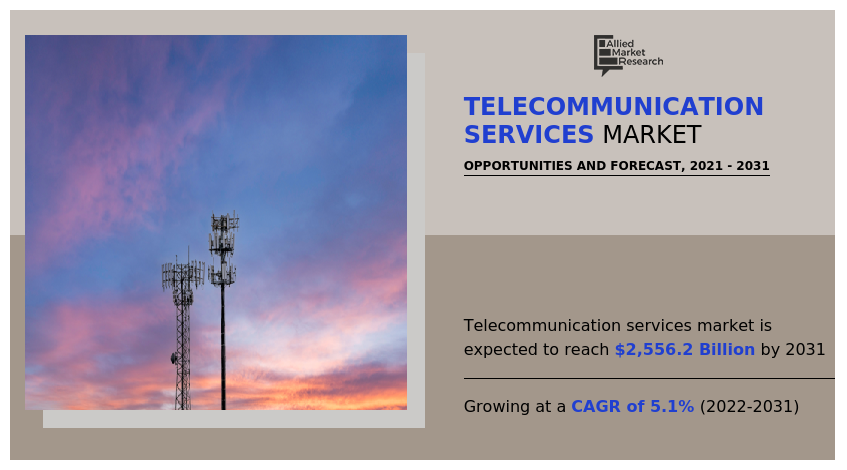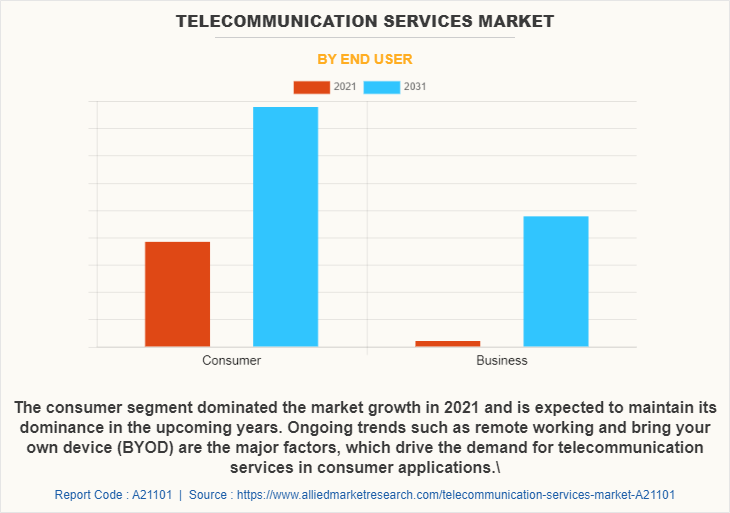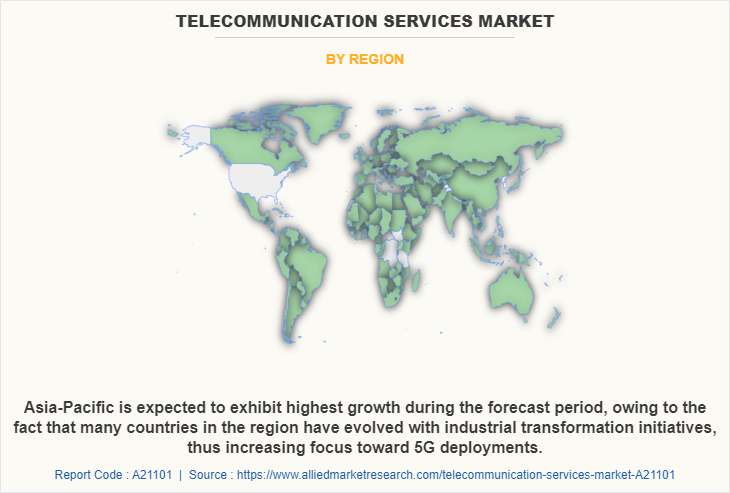Telecommunication Services Market Overview
The global telecommunication services market size was valued at USD 1602.5 billion in 2021, and is projected to reach USD 2556.2 billion by 2031, growing at a CAGR of 5.1% from 2022 to 2031.
Increased mobile data traffic, fiber deployment required for connectivity, and 5G network is boosting the telecommunication services market growth. However, government network radiation rules is hampering the telecommunication services market growth. On the contrary, emergence of internet of things (IoT) is expected to offer remunerative opportunities for expansion during the telecommunication services market forecast.

Telecommunications services have proved very beneficial for businesses as they facilitate effective communication with their customers and help establish a healthy relationship with them. Telecommunications services are also beneficial for the employees as they enable easy transmission of data and provide efficiency and flexibility. With the adoption and integration of cutting-edge communication technologies like 5G, IoT, NB-IoT, and many others, the global telecommunications market has been undergoing constant transformation. Through a wired or wireless channel, telecommunication is an infrastructure that enables the movement of various forms of data, including speech, text, audio, and video, at anytime and anywhere in the globe.
The field of telecommunications has developed into a vibrant industry that has a big impact on global social and economic progress. The telecommunications industry is expanding its services and coverage throughout the world and solidifying its place in people's daily lives. Providers of phone, telecommunications, and internet services are included in the telecom sector.
Segment Review
The telecommunication service market is segmented on the basis of service type, transmission, end user, and region. Based on service, it is segmented into mobile data services, fixed internet access services, mobile voice services, fixed voice services, pay-tv services, and mobile messaging. Based on transmission, the market is categorized into wireline services and wireless services. Based on end user, the market is categorized into consumer and business. Based on business, the telecommunication services industry is categorized into manufacturing, energy & utilities, transportation & logistics, government, healthcare, retail, and others. Region wise, it is analyzed across North America, Europe, Asia-Pacific and LAMEA.
Depending on end-user, consumer segment is dominating the telecommunication services market Share and is expected to do so in the forecast period as, Ongoing trends such as remote working and bring your own device (BYOD) are the major factors, which drive the demand for telecommunication services in consumer applications.
In addition, with growing need for wide and strong connectivity, enterprises are opting for telecommunication services that transmit at power levels between around 0.02 watts and 0.25 watts, with a range of up to around 200 meters. This helps the telecom operators to lower the power consumption, as well as desired quality of service and multiple users are achieved. Increase in telecommunication services deployment in urban areas that transmit at power levels between around 0.25 and 6.0 watts, giving extra coverage and capacity to serve multiple users is further positively supporting the market growth.

Depending on the region, North America dominated the telecommunication services market in 2021, as a result of the enormously high demand from businesses for on-demand services, real-time user contact, and effective storage management. However, Asia-Pacific is expected to exhibit highest growth during the forecast period, owing to the growing importance of smart technologies, IoT-powered devices, Big Data, Industry 4.0, 5G, and cloud computing in this region.

Major Industry Players
Key players operating in the telecommunication services industry include Alcatel Lucent Enterprise, AT&T Inc., Bharti Airtel Limited, Cisco Systems Inc., China Mobile Limited, Deutsche Telekom, International Business Machine Corporation (IBM), Juniper Network, KT Corporation, Nippon Telegraph and Telephone Corporation (NTT), Nokia Corporation, Reliance, Softbank Corporation, TATA, Telefonica Corporation, Verizon Communications Inc., and Vodaphone Group. Furthermore, it highlights the strategies of the key players to improve the market share and sustain competition
Top Impacting Factors
Increased mobile data traffic
Internet material is transported to different mobile consumer electronics, such as smartphones and tablets, through mobile data traffic. The industry is expanding due to the worldwide increase in mobile data traffic. By 2024, it is anticipated that global mobile traffic would have increased by a factor of 5, totaling 136EB each month. Additionally, it is anticipated that by 2024, 5G networks would handle almost one-third of all mobile data traffic worldwide. The demand for technologically advanced telecommunication networks is therefore projected to develop significantly as a result of the noticeable increase in mobile data traffic.
The market for telecommunication service is anticipated to be driven by a rise in network upgrading needs as a result of the exponential growth in mobile data traffic. Customers will benefit from effective network quality thanks to the rollout of the 5G network. Additionally, global mobile data traffic in 2018 increased by more than 71% year over year, totaling more than 138 Exabytes.
Fiber Deployment Required For Connectivity
Nowadays, telecommunications companies are augmenting its network capacity, this fact is becoming one of the most remarkable trends for telcos in 2022. Hence, fiber optics deployment is entering the largest investment cycle ever. The benefits provided by this astonishing technology can fulfill all customers’ needs and expectations, given that it scores higher than any other broadband technology. With 3 billion internet users in the world, who are looking for higher speed connectivity, innovations such as 5G network, Fiber to the Home (FTTH) and Fiber to the Building (FTTB) have amplified the positioning of these network systems.
Furthermore, this solution simplifies businesses processes and minimize costs in any sector if used efficiently, as we discussed previously in 2021 telecom trends. Moreover, connections to 5G are about to reach 1.34 billion in 2022, according to a report from CCS insight. Moreover, fiber deployment, being a key issue in the digital development of territories, provides widespread access for all too very high-speed broadband. Data published by the Organization for Economic Co-operation and Development (OECD) shows an uneven deployment of fiber optics among OECD’s member countries.
Impact of COVID-19
The current estimation of 2031 is projected to be lower than pre-COVID-19 estimates. The COVID-19 outbreak has low impact on the growth of the telecommunication services industry, owing to the fact that the government and private sectors in emerging countries are working together to speed up the development of 5G infrastructure in the wake of the pandemic. For instance, in Thailand, mobile network operators (MNO) are joining forces to provide 5G networks to hospitals. The Eastern Economic Corridor (EEC), which is a special development zone of Thailand, mandates that 5G must cover approximately 50% of the area in 2020, which means that the equipment installation must commence this year in industrial areas.
Key Benefits For Stakeholders
This report provides a quantitative analysis of the market segments, current trends, estimations, and dynamics of the telecommunication services market analysis from 2021 to 2031 to identify the prevailing telecommunication services market opportunities.
The market research is offered along with information related to key drivers, restraints, and opportunities.
Porter's five forces analysis highlights the potency of buyers and suppliers to enable stakeholders make profit-oriented business decisions and strengthen their supplier-buyer network.
In-depth analysis of the telecommunication services market segmentation assists to determine the prevailing market opportunities.
Major countries in each region are mapped according to their revenue contribution to the global market.
Market player positioning facilitates benchmarking and provides a clear understanding of the present position of the market players.
The report includes the analysis of the regional as well as global telecommunication services market trends, key players, market segments, application areas, and market growth strategies.
Telecommunication Services Market Report Highlights
| Aspects | Details |
| By Service Type |
|
| By Transmission |
|
| By End User |
|
| By Region |
|
| Key Market Players | Nippon Telegraph & Telephone Corp., VODAFONE, Cisco Systems Inc., Softbank Corp., Juniper Networks, Alcatel Lucent, Telefonica SA, AT&T Inc., IBM CORPORATION, China Mobile, Bharti Airtel, KT Corp., Nokia, Reliance, Deutsche Telekom, Verizon Communication |
Analyst Review
In accordance with insights by CXOs of leading companies, the telecommunication services market is growing, owing to 5G networks and availability of smartphones as well as e-commerce. Japan, India, and China are key countries in growth of the market. India and China were the leading global Internet users with around 854 billion clients as stated by the International Telecommunication Union. Increase in government initiatives by incorporating ICT are expected to help in expansion of the Asia-Pacific market. Introduction of International Finance Corporation in North America and European countries is also expected to help the market grow. Asia-Pacific is expected to dominate this market, owing to rapidly growing population, rise in internet penetration, and adoption of smartphones.
Companies are focusing on leveraging new technologies to offer advanced 5G network solutions to cater to evolving end-user requirements. Key players have adopted various growth strategies to enhance and develop their product portfolio, garner maximum market share, and increase their market penetration. Furthermore, constant need has been witnessed for technological advancements in communication networks to adjust with the increasing mobile data traffic management demand, owing to which adoption of telecommunication services is expected to increase in the upcoming years. For instance, northeastern part of Asia-Pacific is the most populated area and has generated largest mobile data traffic share of about 30%, globally in 2019. The emerging mobile broadband subscriptions is another factor adding to the regional market demand.
Furthermore, continuous increase in mobile data traffic is positively impacting the telecommunication services market growth. According to the Cisco Visual Networking Index (VNI) Global Mobile Data Traffic Forecast, mobile data traffic is expected to grow at a CAGR of 46% from 2018 to 2022, reaching 77.5 Exabyte’s per month by 2022. In addition, the study states that by 2022, a 5G connection will generate 2.6 times more traffic than the average 4G connection. Thus, demand for advanced telecommunication network has increased due to continuous rise in mobile data traffic. In addition, the demand for 5G network is expected to increase in the upcoming years, owing to increase in number of connected devices and requirement of small cells for large bandwidth applications. For instance, according to Cisco Systems Inc., almost 500 billion devices are expected to be connected to the internet by 2030.
The global telecommunication services market was valued at $1,602.5 billion in 2021, and is projected to reach at $2,556.2 billion by 2031
The telecommunication services market is projected to grow at a compound annual growth rate of 5.1% from 2021 to 2031.
Key players operating in the market include Alcatel Lucent Enterprise, AT&T Inc., Bharti Airtel Limited, Cisco Systems Inc., China Mobile Limited, Deutsche Telekom, International Business Machine Corporation (IBM), Juniper Network, KT Corporation, Nippon Telegraph and Telephone Corporation (NTT), Nokia Corporation, Reliance, Softbank Corporation, TATA, Telefonica Corporation, Verizon Communications Inc., and Vodaphone Group. Furthermore, it highlights the strategies of the key players to improve the market share and sustain competition
North America dominated the telecommunication services market
Increased mobile data traffic, fiber deployment required for connectivity, and 5G network is boosting the growth of the global telecommunication services market. However, government network radiation rules are hampering the telecommunication services market growth. On the contrary, emergence of internet of things (IoT) is expected to offer remunerative opportunities for expansion during the telecommunication services market forecast.
Loading Table Of Content...



